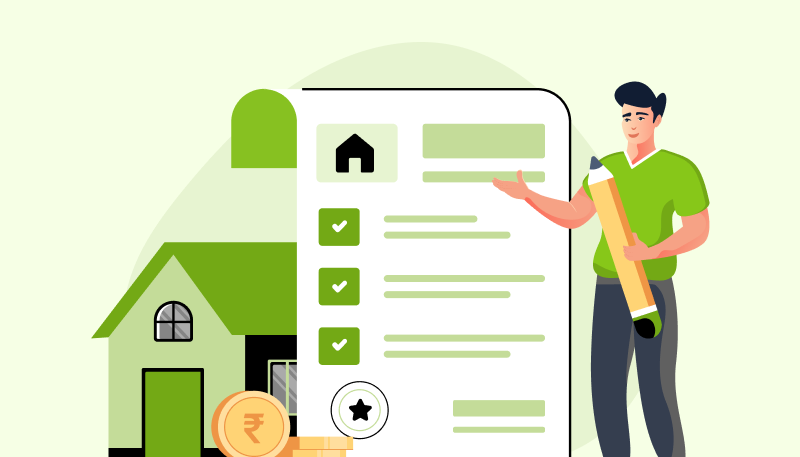“I’m here to apply for a home loan,” – Naina, who always dreamt of owning her own house, said with a confident smile to the bank employee.
The bank representative nodded and began explaining, “Great! Let’s discuss the home loan interest rates, EMI options, and your home loan eligibility first.”
Naina blinked, her excitement dimming a little – “Wait… interest rates? EMI? Eligibility? Isn’t it just about getting the loan and paying it back monthly?”
Naina’s story is common. Whether you are buying your first home or upgrading to a larger one, understanding home loan interest rates and EMI options can feel daunting. But don’t worry – this guide will take you through every aspect in detail to make the process less intimidating. From different types of interest rates to understanding the impact of tenure, we’ll explore every angle to ensure that you’re equipped with the right knowledge for your home loan journey.
What Are Home Loan Interest Rates?
A home loan interest rate is the cost you incur when borrowing money from a lender to purchase a home. The interest rate is applied to the principal amount (the total loan amount), and it is usually expressed as an annual percentage rate (APR). Home loan interest rates directly affect your monthly repayment, or EMI, and the total cost of the loan over time.
The rate at which you are charged interest varies depending on several factors. These rates can either be fixed or floating. Let’s break down these terms further to understand them better.
Types of Home Loan Interest Rates
- Fixed Interest Rate
With a fixed interest rate, the rate remains constant throughout the loan term, no matter how market conditions fluctuate. This ensures that your EMI remains the same throughout the entire tenure of the loan, making budgeting easier and more predictable. If you’re someone who values financial stability and prefers to know exactly what you’ll be paying each month, this could be a good option.
Example: Fixed-Rate Loan
Imagine Naina opts for a fixed-rate loan of ₹50 lakh at an interest rate of 8.0%. She chooses a 20-year tenure for her home loan. Her EMI will be fixed at ₹42,194 for the entire loan term. This consistency allows her to plan her finances without worrying about the market impacting her monthly payment.
Pros of Fixed Interest Rate:
- Stability: Your EMI remains the same, so budgeting is predictable.
- Protection against rate hikes: Your loan is shielded from interest rate hikes.
- Suitable for long-term financial stability: Especially useful if you prefer no surprises over time.
Cons of Fixed Interest Rate:
- Higher interest rate: Fixed interest rates are often higher than floating rates initially.
- No benefit from falling rates: You miss out on reduced payments if market rates drop.
- Prepayment penalties: Some lenders impose prepayment charges or penalties for early repayment or refinancing.
- Floating Interest Rate
A floating interest rate fluctuates with the market conditions. The rate is usually linked to a benchmark rate, such as the Repo Rate or Marginal Cost of Lending Rate (MCLR). The lender will adjust the rate based on changes in the benchmark rate, which is influenced by factors such as inflation, economic conditions, and RBI’s monetary policy.
Example: Floating-Rate Loan
Suppose Naina takes a floating-rate loan of ₹50 lakh at an initial rate of 7.0%. However, since floating rates are subject to change, her EMI may fluctuate as the interest rate moves up or down. If the interest rate increases to 8.5% after a few years, her EMI may rise significantly, but if the rate decreases, her EMI will reduce accordingly.
Pros of Floating Interest Rate:
- Lower initial rates: Typically lower than fixed interest rates at the outset.
- Benefit from market rate drops: Your EMI may reduce if market rates decrease.
- Flexibility: Some floating-rate loans offer more flexibility in terms of repayment and restructuring.
Cons of Floating Interest Rate:
- Uncertainty: You can’t predict future EMIs since they depend on market conditions.
- Increased payments: Your EMI could increase if the benchmark rate goes up.
- Difficulty in budgeting: The unpredictability makes it harder to plan for long-term expenses.
Home Loan EMI Calculations: Understanding the Numbers
An Equated Monthly Installment (EMI) is the amount you will pay monthly to repay the home loan, which includes both principal repayment and interest. The EMI amount depends on three key components:
- Principal Amount (P) – The loan amount you borrow.
- Interest Rate (R) – The annual interest rate divided by 12 to calculate the monthly interest rate.
- Loan Tenure (N) – The number of months for which the loan will be repaid.
Let’s break down how these factors influence your EMI.
Formula for Calculating EMI
The formula for EMI calculation is: EMI=P×R×(1+R)N(1+R)N−1EMI = \frac{P \times R \times (1 + R)^N}{(1 + R)^N – 1}EMI=(1+R)N−1P×R×(1+R)N
Where:
- P = Principal loan amount
- R = Monthly interest rate (annual rate divided by 12)
- N = Number of months in the loan tenure
Let’s go ahead and look at the detailed example of Naina’s loan EMI.
Detailed Example: Naina’s Loan EMI
Let’s take a deeper look at how to calculate Naina’s home loan EMI for both fixed and floating-rate loans.
Loan Details:
- Principal loan amount (P): ₹50,00,000
- Interest rate: 8% annual (fixed) or 7.5% (floating initially)
- Tenure: 20 years (240 months)
Fixed-Rate EMI Calculation
- Interest rate (annual): 8%
- Monthly interest rate (R): 8% / 12 = 0.67% = 0.0067
- Loan Tenure (N): 20 years = 240 months
Substituting into the EMI formula: EMI=50,00,000×0.0067×(1+0.0067)240(1+0.0067)240−1EMI = \frac{50,00,000 \times 0.0067 \times (1 + 0.0067)^{240}}{(1 + 0.0067)^{240} – 1}EMI=(1+0.0067)240−150,00,000×0.0067×(1+0.0067)240
After solving, we get an EMI of ₹42,194 per month.
Floating-Rate EMI Calculation
For a floating-rate loan at an initial rate of 7.5%, the calculations would be as follows:
- Interest rate (annual): 7.5%
- Monthly interest rate (R): 7.5% / 12 = 0.625% = 0.00625
- Loan Tenure (N): 20 years = 240 months
Substituting into the EMI formula: EMI=50,00,000×0.00625×(1+0.00625)240(1+0.00625)240−1EMI = \frac{50,00,000 \times 0.00625 \times (1 + 0.00625)^{240}}{(1 + 0.00625)^{240} – 1}EMI=(1+0.00625)240−150,00,000×0.00625×(1+0.00625)240
After solving, we get an EMI of ₹40,280 per month.
In this case, Naina would initially pay ₹40,280 for the floating-rate loan, compared to ₹42,194 for the fixed-rate loan. The floating-rate option offers a lower EMI initially but comes with the potential risk of increased payments in the future if market rates rise.
Factors Affecting Home Loan Interest Rates
Lenders consider multiple factors when determining the interest rate for your home loan. These factors include your creditworthiness, the tenure of the loan, your income stability, and the prevailing economic conditions. Let’s take a look at these factors in more detail:
- Credit Score
A high credit score (750 and above) indicates a strong repayment history, making you eligible for a lower interest rate. If you have a low score, lenders may offer you a higher interest rate to compensate for the perceived risk. Maintaining a good credit score can help you save significantly over the life of your loan. - Loan Tenure
Shorter loan tenures tend to have lower interest rates, as the lender’s risk is minimized due to faster repayment. However, shorter tenures mean higher monthly EMIs. On the other hand, longer tenures lead to lower EMIs but higher total interest payments, as the lender’s risk is extended over a longer period. - Income Stability
Lenders look at your income stability to determine your ability to repay the loan. A stable income source, such as a salaried job or a well-established business, can help you secure a more favorable rate. The higher and more consistent your income, the better your chances of qualifying for a competitive interest rate. - Down Payment
The larger your down payment, the lower the loan-to-value ratio (LTV), which reduces the risk for the lender. By offering a larger down payment, you reduce the lender’s risk, and they may offer you a lower interest rate. - Property Type
The type of property you’re purchasing also plays a role in determining your interest rate. If you’re buying a newly constructed home or a property in a prime location, the lender may offer a lower interest rate due to the higher value and marketability of the property. - Economic Conditions
In a growing economy, interest rates may be relatively higher due to inflation, while in a recessionary environment, lenders may lower their interest rates to encourage borrowing. Government monetary policies (such as changes in the repo rate by the Reserve Bank of India) play a significant role in shaping home loan rates.
How to Choose the Right EMI Option?
Selecting the right EMI plan for your home loan is crucial, as it determines your monthly financial burden and the total amount paid over the loan’s lifetime. Here are some key considerations when choosing the right EMI option:
- Assess Your Monthly Budget
As a rule of thumb, your EMI should not exceed 40-45% of your monthly income. This ensures that you’re not overstretching your finances and can meet other essential expenses. If your income is ₹1,00,000 per month, your EMI should ideally not be more than ₹40,000 to ₹45,000. - Look for Prepayment and Part-Payment Flexibility
Many home loan lenders allow prepayment or part-payment, which helps in reducing the loan principal and, ultimately, the interest paid. Always look for loans with flexible prepayment policies. Some lenders may charge penalties for prepayments, while others may allow penalty-free prepayment. - Compare Loan Tenure Options
Shorter tenures will result in higher EMIs but will save you money in the long run, as you will pay less interest overall. On the other hand, longer tenures may seem attractive due to lower EMIs but will lead to higher total interest payments. Let’s consider a 20-year tenure loan of ₹50 lakh:
- 20-year loan at 8% = ₹42,194 EMI and ₹46,67,125 interest paid
- 10-year loan at 8% = ₹59,104 EMI and ₹20,92,460 interest paid
Choosing a 10-year loan will save you ₹25,74,665 in interest, even though the EMI is higher.
- Consider Refinancing Options
Keep an eye on opportunities to refinance your home loan at a lower interest rate, especially when interest rates fall. Refinancing can help lower your monthly EMI and reduce the total interest paid over the life of the loan. - Account for Life Changes
Consider how changes in your life might affect your ability to repay the loan. For example, if you expect to have a family, or if your job situation might change, you may want a loan with more flexibility or shorter tenure.
Final Thoughts
Understanding home loan interest rates and EMI options is critical for making informed financial decisions. Whether you are taking a fixed or floating interest rate loan, or choosing a long-term or short-term tenure, knowing how each decision impacts your finances can help you choose the best option.
By utilizing online calculators, maintaining a good credit score, and evaluating your monthly budget, you can plan your finances and manage your loan effectively. Remember, purchasing a home is a long-term commitment, and choosing the right loan can make all the difference in making that commitment financially manageable.
With the right planning and guidance, your dream home is within reach – just like Naina’s!




